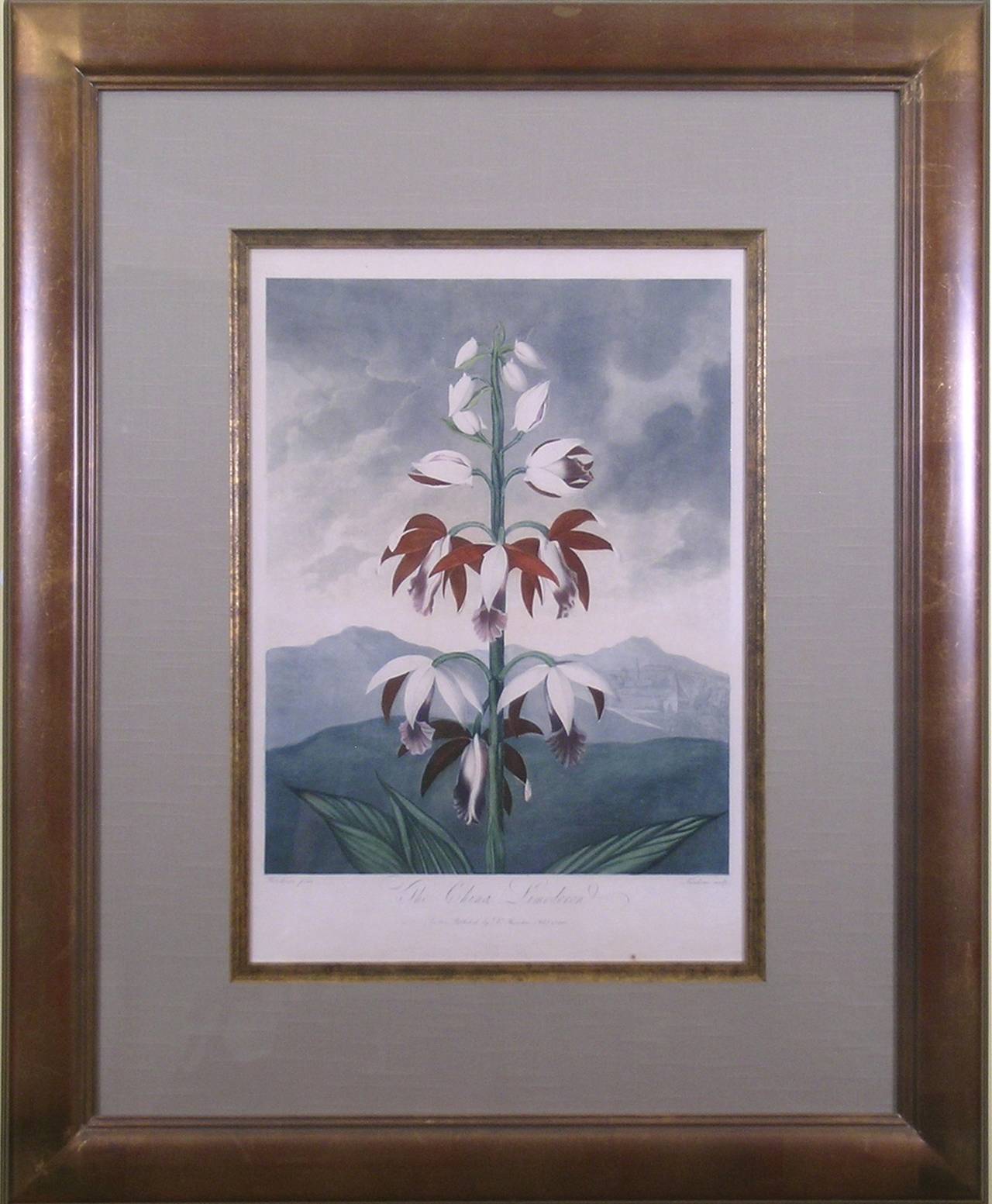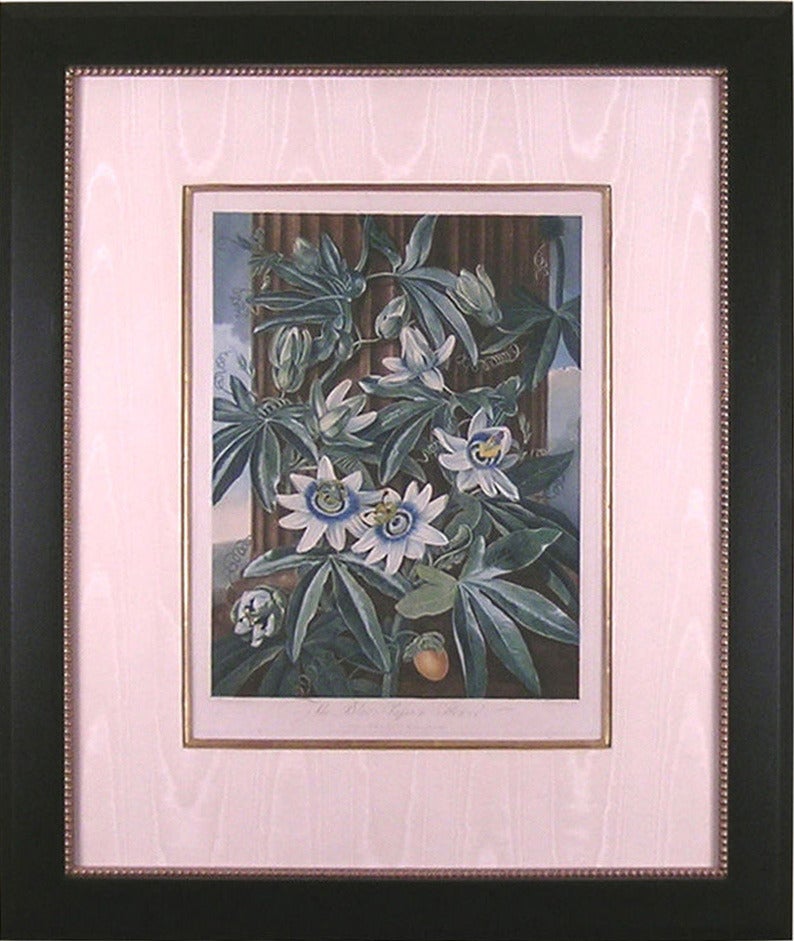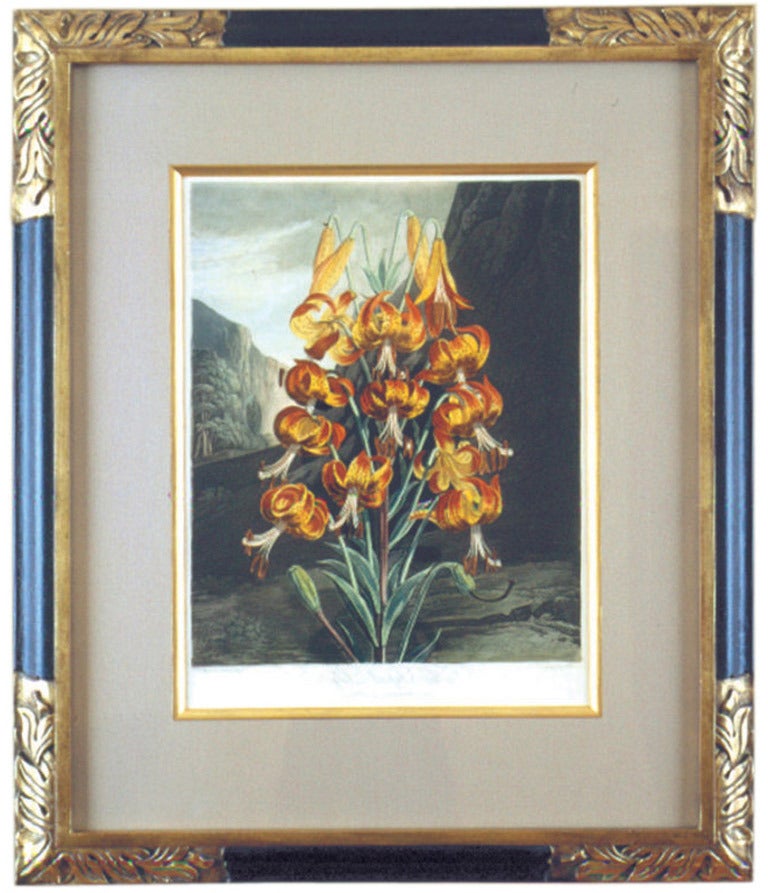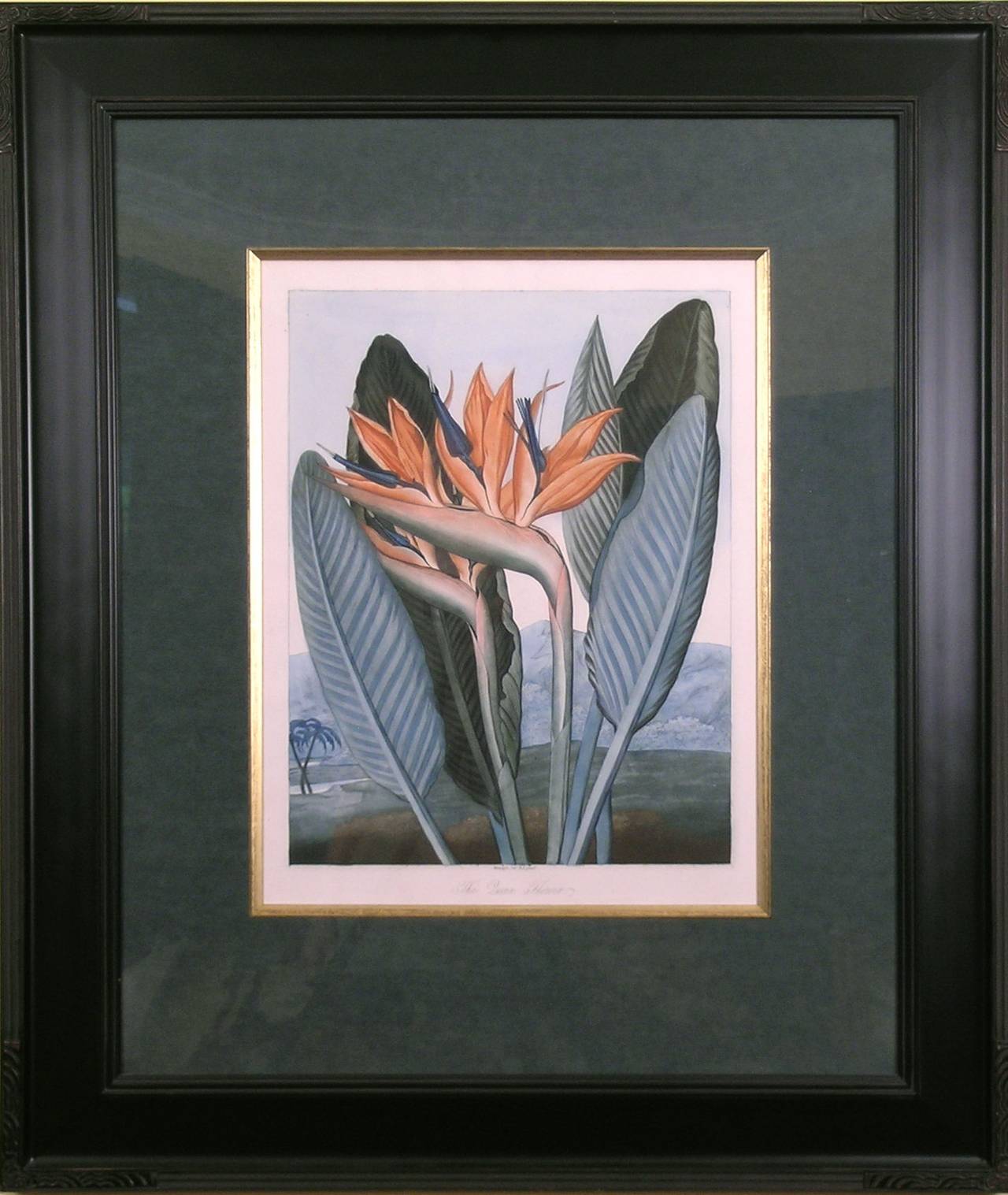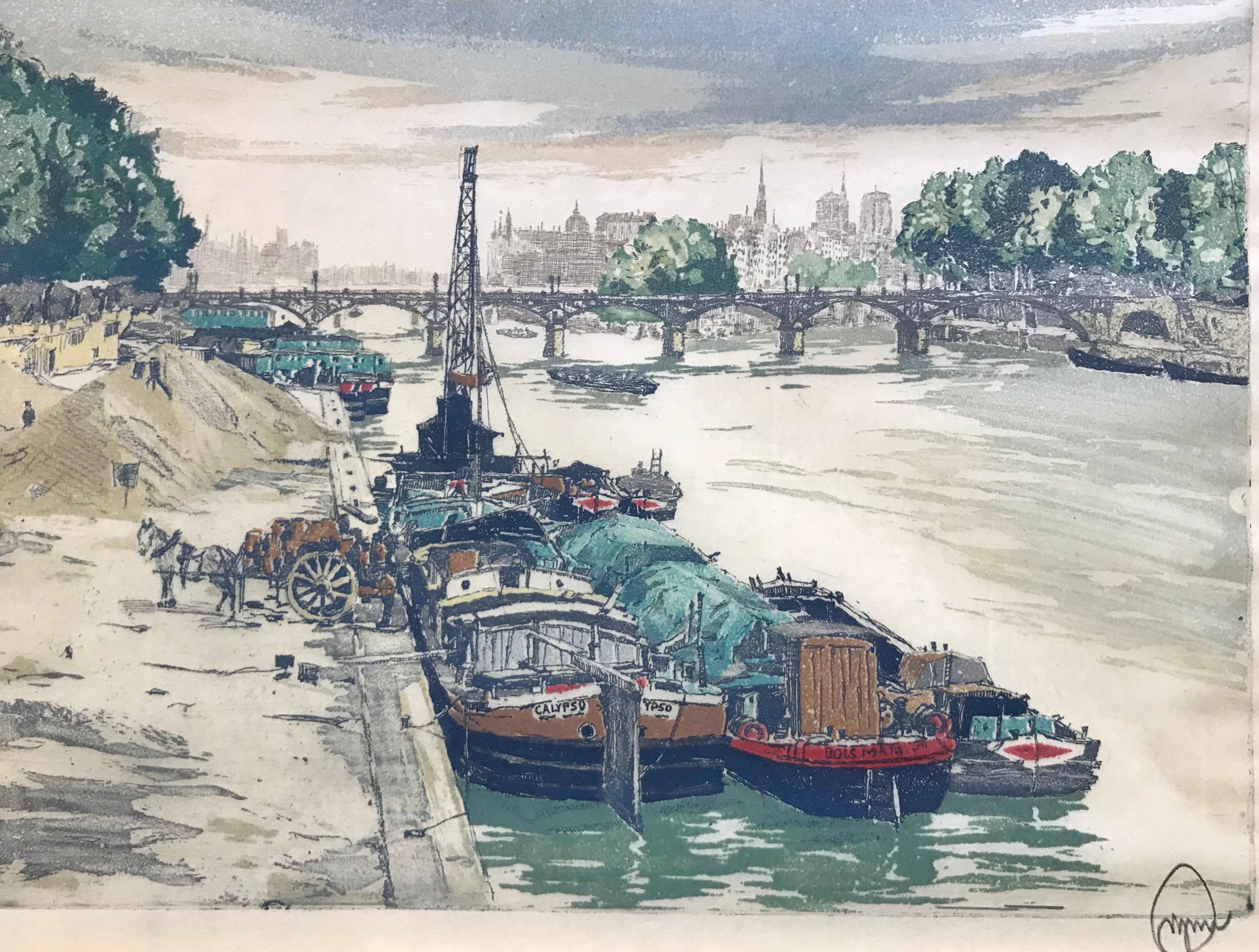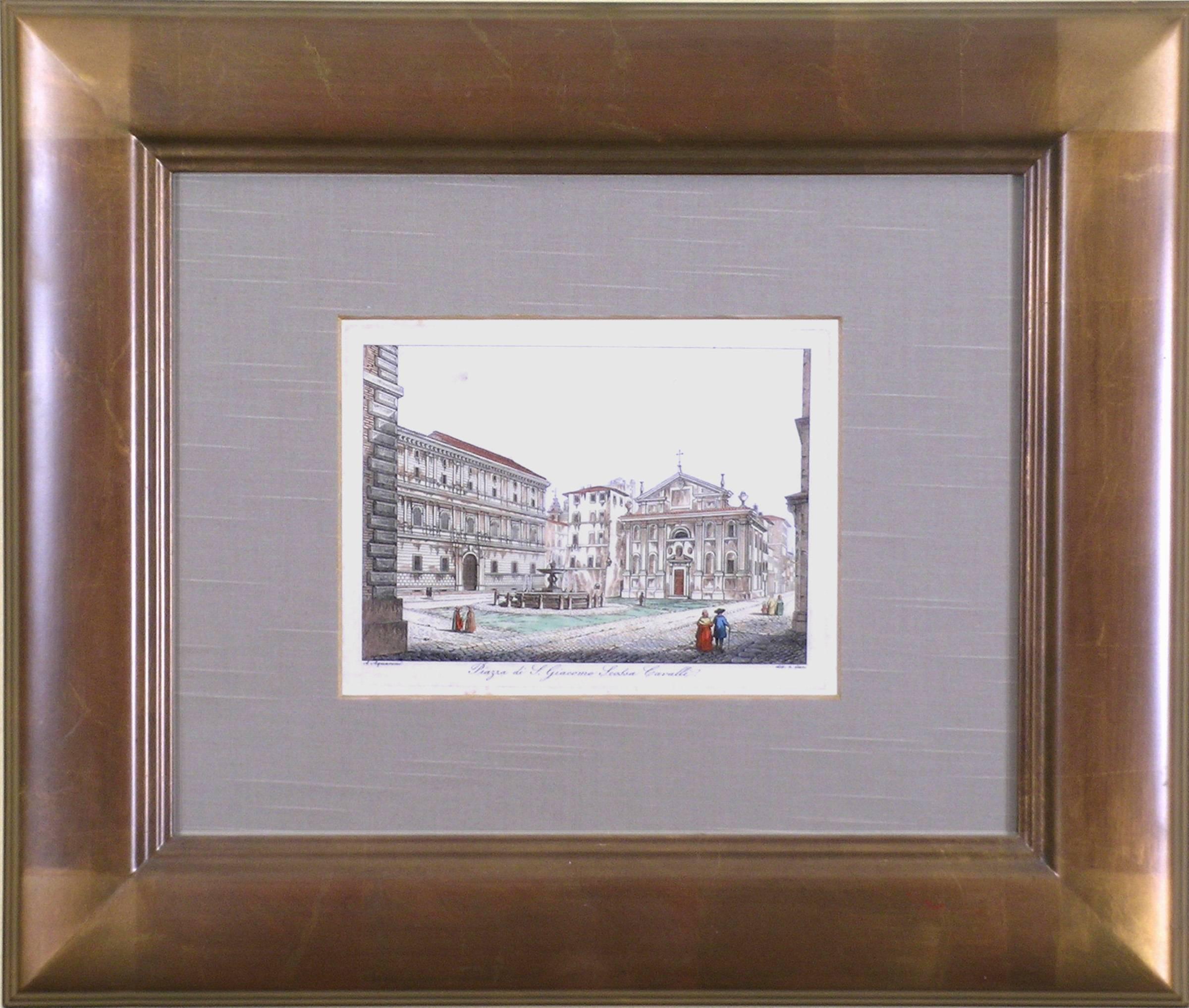Items Similar to The Narrow-Leaved Kalmia (Mountain Laurel)
Want more images or videos?
Request additional images or videos from the seller
1 of 7
Dr. Robert John ThorntonThe Narrow-Leaved Kalmia (Mountain Laurel)1798-1810
1798-1810
About the Item
DR. ROBERT JOHN THORNTON (c1765 – 1832).
The Temple of Flora.
London, 1798-1810.
Painted by Reinagle, Henderson, Pether, et. al.
Engraved by Ward, Caldwall, Earlom, et. al.
Aquatint, mezzotint, and/or stipple engraving finished by hand.
Approximately 17.75” x 22.5” Unframed.
5 frontice pieces, 32 plates; generally 29-30 per volume, 1 or more frontice pieces.
As a boy, Robert John Thornton (d.1837) demonstrated his love of natural history with his own botanical garden and an aviary, which contained every species of English hawk, most of them captured by himself. He took his Cambridge M.B. and, following in his father's footsteps, set up practice as a London doctor. Upon inheriting the family fortune in 1797, Thornton desired to leave his mark on the world in the form of a massive work dedicated to Carolus Von Linnaeus, the great Swedish naturalist. For his own aggrandizement and that of his beloved England, Thornton wished it to surpass in scope, illustration, paper, and topography any publication produced in any other European country. He felt he was engaged upon "a national undertaking", and dedicated this homage of philosophic and literary distinction to Queen Charlotte. It was to be titled The Temple of Flora; or Garden of Nature Picturesque Botanical Plates of the New Illustration of the Sexual System of Linnaeus. Desiring the national glorification of botany and its alliance with the arts of painting and engraving, Thornton was the first person to juxtapose landscape backgrounds with his floral subjects. He opened an art gallery of the paintings from which the prints were made and subscriptions for the forthcoming books were sold. Copies of the work were sent to the Queen and Prince Regent, and to the Emperor of Russia, who sent Thornton a ring in acknowledgment of the "splendid and elaborate Botanical works."
The Thornton prints, originally to number seventy in all, were barely published in an edition of thirty at the author's expense between the years 1799 and 1807. Despite his efforts, Thornton was unable to succeed financially. Technically The Temple of Flora, as it came to be known, was not a success due to botanical inaccuracies and rather insipid text all based on Thornton's aesthetic sense. However, it is the forceful stylization of flowers, together with their historical, allegorical and fanciful backgrounds that place The Temple of Flora among the greatest botanical books of all time.
Though Thornton actually painted only one picture used for the engravings in his Temple, "The Roses", he literally directed his flower pictures. He chose the plants, arranged the symbolism and the backgrounds. For example, in the "Night-Blowing Cereus" the moon illuminates the turret clock, which has just struck midnight, the hour when this flower is fully open. Henderson, Reingal, Edwards and Pether are among the artists hired by Thornton to work on the flower designs and their backgrounds. Many times they would collaborate, as in the aforementioned "Cereus" where it states "The Flower by Reinagel, Moonlight by Pether". These plates were executed by the likes of Bartolozzi and other English master engravers and are a varied combination of mezzotint, aquatint, stipple engraving and finished in watercolor by hand. The text, primarily composed by Thornton, was lengthy, somewhat fanciful and included rather exaggerated poetry. Thornton was a man of his era, a time of romanticism, when artistic tastes ran to the sentimental, symbolic, and dramatic. The flowers from the Temple of Flora are delightful examples of that style.
In spite of tremendous public exposure and a dedication to Queen Charlotte, Thornton's venture was a financial disaster. While he attributed this to the continental war, no doubt his over-zealous attention to details, none too scientific, largely contributed to his failure. By 1811, Thornton was forced to petition Parliament for permission to set up a lottery. "An Act to enable Dr. Robert John Thornton to dispose of his collection of paintings, drawings and engravings, together with several copies of certain books therein mentioned, by way of chance" was passed in May of that year. Thus, the Quarto or Lottery edition of The Temple of Flora was published. This work, smaller in scale but not in romantic spirit, was to salvage Thornton's expenses for the original folio edition. Hoping to sell twenty thousand tickets at two guineas each, Thornton estimated the worth of his ten thousand prizes to be 77,000 pounds. This was a generous estimate as the complete sale of tickets would be worth no more than 42,000 pounds. Once again, Thornton's venture resulted in disaster. For the remaining years of his life, Thornton continued his medical practice with varying success, and attempted a brief, unhappy collaboration with the poet William Blake. Sadly when he died in 1837 his family was almost destitute. But despite these early failures, The Temple of Flora has now a permanent place as one of the greatest prizes of all time.
Reference:
Flower & Fruit Prints. Dunthorne. Da Capo Press. Washington, D. C., 1938.
The Temple of Flora: Robert Thornton. King. Little, Brown and Company, NY, 1981.
- Creator:Dr. Robert John Thornton (1768 - 1837, English)
- Creation Year:1798-1810
- Dimensions:Height: 35 in (88.9 cm)Width: 29 in (73.66 cm)
- Medium:
- Movement & Style:
- Period:
- Condition:Clean, crisp image. Beautiful original colors. Framed to museum specifications using archival matting, backing, and hinging. Silk matting with wooden frame and fillet. Glazed with ultra-violet filtering Plexiglas.
- Gallery Location:Florham Park, NJ
- Reference Number:
About the Seller
5.0
Vetted Seller
These experienced sellers undergo a comprehensive evaluation by our team of in-house experts.
1stDibs seller since 2014
161 sales on 1stDibs
Typical response time: 2 hours
- ShippingRetrieving quote...Ships From: Florham Park, NJ
- Return PolicyA return for this item may be initiated within 1 day of delivery.
More From This SellerView All
- The China Limodoron (Orchid)By Dr. Robert John ThorntonLocated in Florham Park, NJDR. ROBERT JOHN THORNTON (c1765 – 1832). The Temple of Flora. London, 1798-1810. Painted by Reinagle, Henderson, Pether, et. al. Engraved by Ward, Caldwall, Earlom, et. al. A...Category
Early 19th Century Academic Prints and Multiples
MaterialsAquatint, Engraving, Mezzotint, Watercolor
- The Blue Passion FlowerBy Dr. Robert John ThorntonLocated in Florham Park, NJDR. ROBERT JOHN THORNTON (c1765 – 1832). The Temple of Flora. London, 1798-1810. Painted by Reinagle, Henderson, Pether, et. al. Engraved by Ward, Caldwall, Earlom, et. al. A...Category
Early 19th Century Academic Prints and Multiples
MaterialsAquatint, Watercolor, Archival Paper, Archival Tape, Engraving, Handmade...
- The Superb LilyBy Dr. Robert John ThorntonLocated in Florham Park, NJDR. ROBERT JOHN THORNTON (c1765 – 1832). The Temple of Flora. London, 1798-1810. Painted by Reinagle, Henderson, Pether, et. al. Engraved by Ward, Caldwall, Earlom, et. al. A...Category
18th Century and Earlier Academic Prints and Multiples
MaterialsArchival Paper, Watercolor, Archival Tape, Engraving, Gesso, Handmade Pa...
- The Queen Flower (Bird of Paradise)By Dr. Robert John ThorntonLocated in Florham Park, NJDR. ROBERT JOHN THORNTON (c1765 – 1832). The Temple of Flora. London, 1798-1810. Painted by Reinagle, Henderson, Pether, et. al. Engraved by Ward, Caldwall, Earlom, et. al. A...Category
18th Century and Earlier Academic Prints and Multiples
MaterialsAquatint, Engraving
- Piazza de San Giacomo (Italy)By Antonio AquaroniLocated in Florham Park, NJROMA (Italy) A. Aquaroni. Engraving. Modern Hand-Color. Rome, Italy 1750. Ever wonder what pre-dated the postcard? By the mid-eighteenth century, travel and exploration had be...Category
1750s Academic Prints and Multiples
MaterialsWatercolor, Engraving
- L'Etoile du BergerBy J. J. GrandvilleLocated in Florham Park, NJJ. J. GRANDVILLE (1803-47). aka Jean Ignace Isidore Gerard Les Etoiles. Text by Joseph Mery (1798-1865). Engraved by Geoffroy. Paris, 1849. Steel engravings with original hand...Category
Mid-19th Century Academic Prints and Multiples
MaterialsGold Leaf
You May Also Like
- “On the Seine, Paris”Located in Southampton, NYOriginal aquatint engraving of working river barges on the Seine in Paris, France. A horse drawn cart is seen loading or unloading product. Circa 1900. ...Category
Early 1900s Academic Landscape Prints
MaterialsMezzotint, Paper
- Bird and Beetle - Etching and watercolor (Natural History of Birds, 1741)By George EdwardsLocated in Paris, FRGeorge EDWARDS Bird and beetle ('The Gowry Bird') Original engraving, enhanced with watercolor Printed signature in the plate Dated, 1741 28.8 x 23.3 cm Created for Volume I of the...Category
1740s Academic Animal Prints
MaterialsWatercolor, Engraving
- "The Game of Transformation. Butterflies"Located in Sempach, LUThe etching "The Game of Transformation. Butterflies" is an artist's play with meanings and associations. In this work, modern girls are presented in the form of glamorous fluttering...Category
2010s Aesthetic Movement Animal Prints
MaterialsPaper, Mulberry Paper, Mezzotint, Etching, Aquatint
- FragmentBy Noriko YanagisawaLocated in Storrs, CTFragment. 2001. Etching, aquatint and mezzotint. 11 1/2 x 10 3/4 (sheet 20 1/2 x 15). Edition 30, #7. A fine impression printed on the full sheet with deckle edges. Presentation prin...Category
21st Century and Contemporary Abstract Abstract Prints
MaterialsAquatint, Mezzotint, Etching
- American Modernist "Feast of Pure Reason" Aquatint Mezzotint Etching WPA ArtistBy Jack LevineLocated in Surfside, FLJack Levine, American, 1915–2010 The Feast of Pure Reason, 1970 Etching, mezzotint and aquatint on copper in black ink. 20 w. 25 in., sight overall: 27 x 31.75 in., matted. Depict...Category
1970s Expressionist Figurative Prints
MaterialsMezzotint, Etching, Aquatint
- Black Circle 4, by Guntars SietinsBy Guntars SietinsLocated in Palm Springs, CASigned and numbered from the edition of 20. Completed to accompany the exhibition of his work 'Squaring the Circle', at the Latvian National Museum of Art, Riga in 2017. The illusi...Category
2010s Surrealist Interior Prints
MaterialsMezzotint, Aquatint
Recently Viewed
View AllMore Ways To Browse
Mountain Design
Narrow Art
Dr Brown
Gray Floral Prints
Dr John
Antique And Salvage
Early 18th Century New England
Floral Print Set
The Little King
Antique Floral Prints
Antique Floral Print
The History Of England Books
Set Of Floral Prints
Style And Salvage
Floral Drawing Print
Botanical Print Sets
Botanical Print Set
Sets Of Botanical Prints
